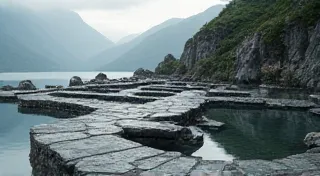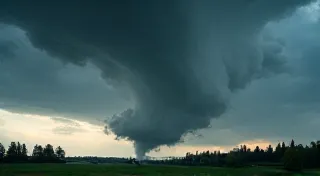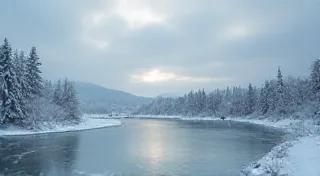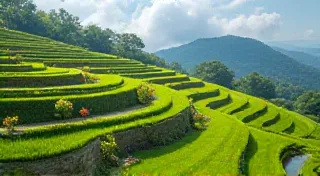Whispers from the Ice Age: How Paleoclimatology is Rewriting the Epic of Gilgamesh
The air in my grandfather's workshop always smelled of oiled wood and the faint melancholy of forgotten music. He was a master accordion repairman, a silent custodian of instruments that had witnessed generations of celebrations, laments, and everything in between. Each repair was a delicate act of archaeology, coaxing life back into a machine that held within it echoes of human experience. I remember, as a child, watching him meticulously clean a particularly ancient instrument, its bellows brittle, its keys yellowed. "These aren't just machines, child," he's say, his voice raspy with age. "They're witnesses. They hold stories. You just have to listen closely." That’s a lesson that’s stayed with me, one that I find resonating in a completely unexpected way, through the lens of paleoclimatology and a closer reading of The Epic of Gilgamesh.

The Epic and Its Ecological Anxiety
The Epic of Gilgamesh, a cornerstone of ancient Mesopotamian literature, is more than just a tale of a tyrannical king's quest for immortality. It's a profound exploration of human ambition, mortality, and the fragility of existence. The narrative is punctuated by devastating floods, relentless droughts, and unpredictable storms – events that seem almost casually woven into the fabric of the story. For centuries, scholars have focused on the epic’s philosophical and psychological depths, often overlooking the stark ecological backdrop against which it's set.
But what if those climatic events weren't simply poetic devices? What if they represented a genuine, lived experience of environmental instability in ancient Mesopotamia? This is where paleoclimatology—the study of past climates—begins to reshape our understanding of the epic. Emerging data from ice cores, sediment analysis, and tree ring studies paint a picture of a region far more volatile than previously imagined. Periods of intense rainfall interspersed with prolonged droughts, all within a timeframe that aligns surprisingly well with the historical context of the epic’s creation and transmission.
Unearthing the Climate Record
Mesopotamia, the "land between the rivers," was, and remains, a region intimately dependent on consistent water resources. The Tigris and Euphrates provided the lifeblood of agriculture and civilization. However, these rivers were also conduits for unpredictable and sometimes catastrophic climatic shifts. Paleoclimatologists are reconstructing this history through painstaking analysis. Sediment cores extracted from the Persian Gulf, for example, reveal evidence of massive freshwater pulses during periods of intense rainfall, events that likely triggered devastating floods in the Mesopotamian plains. Similarly, pollen records indicate sudden shifts in vegetation, signaling rapid changes in temperature and rainfall patterns. The narrative of the great flood in Gilgamesh isn't just mythology; it’s a memory, a deeply ingrained understanding of the devastating power of a rapidly changing environment.
The craftsmanship of the ancient accordions that my grandfather repaired was remarkable. Each button, each reed, meticulously crafted to produce a precise note. Similarly, the Mesopotamians were masters of their environment, developing sophisticated irrigation systems and agricultural techniques to mitigate the effects of climate variability. However, even the most ingenious human ingenuity could only do so much when faced with the full force of a collapsing climate.
Correlations and Interpretations
The parallels are striking. The droughts described in the epic, the famines that plagued the kingdom, the desperate search for a way to cheat death—these aren't just abstract themes; they're potential responses to a real and present ecological crisis. The flood narrative, traditionally interpreted as divine retribution, can also be viewed through a lens of environmental collapse. The epic’s depiction of Enlil, the god of wind and storms, wreaking havoc upon the land could be a reflection of a population struggling to understand and cope with increasingly erratic weather patterns.
It’s important to stress that this isn’t about definitively “proving” that Gilgamesh is a climate change narrative. Rather, it’s about opening up new avenues for interpretation, considering the possibility that the epic’s enduring power lies not just in its exploration of human psychology but also in its reflection of a profound ecological anxiety. The anxieties embedded in the epic—the fear of loss, the yearning for stability, the struggle against inevitable decline—mirror the anxieties of a civilization facing a climate on the brink.

The Legacy of Resilience and Loss
The ancient accordions that passed through my grandfather’s workshop were often found in a state of disrepair, casualties of war, neglect, or simply the relentless passage of time. Each repair was an act of preservation, an attempt to restore a piece of history, a testament to the enduring power of music and human creativity. Similarly, the Mesopotamians struggled to preserve their civilization in the face of environmental challenges. They adapted, they innovated, but ultimately, their kingdom crumbled, a stark reminder of the limits of human control over nature.
The emerging understanding of the climatic context of Gilgamesh adds a layer of complexity and resonance to this timeless masterpiece. It invites us to reconsider the epic not just as a story about human ambition and mortality, but as a poignant chronicle of a civilization grappling with the consequences of a changing climate. The whispers from the ice age are revealing a deeper, more urgent message: a message about the fragility of human existence and the profound interconnectedness of humanity and the natural world.

Beyond the Narrative
The study of past climates, and its intersection with ancient literature, highlights a crucial point: our understanding of the past is constantly evolving. As new data emerges and new methodologies are developed, our interpretations of history are inevitably revised. It serves as a potent reminder of the importance of interdisciplinary collaboration – bringing together the expertise of archaeologists, historians, climatologists, and literary scholars to build a more complete and nuanced understanding of the human experience. Just as my grandfather understood the intricacies of an accordion's mechanism, allowing him to restore it to its former glory, so too must we approach the complexities of history with care, attention, and a willingness to challenge our assumptions.





